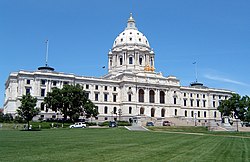| Seventy-sixth Minnesota Legislature | |||||
|---|---|---|---|---|---|
| |||||
 | |||||
| Overview | |||||
| Legislative body | Minnesota Legislature | ||||
| Jurisdiction | Minnesota, United States | ||||
| Meeting place | Minnesota State Capitol | ||||
| Term | January 3, 1989 – January 8, 1991 | ||||
| Website | www | ||||
| Minnesota State Senate | |||||
| Members | 67 Senators | ||||
| President | Jerome M. Hughes | ||||
| Majority Leader | Roger Moe | ||||
| Minority Leader | Duane Benson | ||||
| Party control | Democratic-Farmer-Labor Party | ||||
| Minnesota House of Representatives | |||||
| Members | 134 Representatives | ||||
| Speaker | Robert Vanasek | ||||
| Majority Leader | Ann Wynia, Dee Long | ||||
| Minority Leader | Bill Schreiber | ||||
| Party control | Democratic-Farmer-Labor Party | ||||
The 76th Minnesota Legislature first convened on January 3, 1989. The 67 members of the Minnesota Senate were elected during the General Election of November 4, 1986, and the 134 members of the Minnesota House of Representatives were elected during the General Election of November 8, 1988.